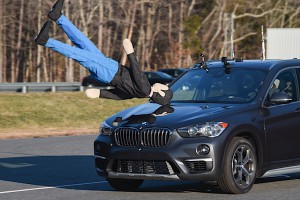
The BMW X1 failed the IIHS pedestrian test, sending the dummy airborne during the exercise. Others suggest SUVs play a large role in rising pedestrian deaths.
Pedestrian deaths continued to rise at an alarming rate last year, reaching a 28-year high, according to new government data.
While a variety of factors appear to be responsible, including the use of smartphones by both drivers and pedestrians, the Governor’s Highway Safety Association also is pointing the finger at the explosive growth of SUVs which, like other light trucks, have tall, blunt noses that make it less likely someone will roll off of a vehicle when struck.
Though formal federal data has yet to be released, the GHSA used statistical data analysis to estimate that 6,227 men, women and children were killed while walking on or alongside U.S. roads last year. If the official numbers back that up it would mark a 4% increase from 2017, and the largest number of pedestrian fatalities since 2018.
Many experts anticipate the numbers will continue to rise as light truck sales continue to grow and as distracted driving and walking remain a problem of epidemic proportions.
(New IIHS tests show wide disparity in automakers’ pedestrian crash avoidance tech. Click Here for more.)
Just last month, legendary Syracuse basketball coach Jim Boeheim became part of the statistics when he struck and killed a man trying to cross I-690 after his vehicle had broken down in the middle lane of the freeway.
Highway deaths, in general, have taken a turn for the worse in recent years, surging in virtually every category. But pedestrian deaths have posted the most significant increase, jumped 51.5% since 2009. That year, 4,109 pedestrians were killed, or 12% of total U.S. traffic fatalities. That rose to around 16% in 2018.
We’ve got to end this tragic problem on our nation’s roadways,” National Transportation Safety Board chairman Robert Sumwalt said during a conference of regulators, safety experts and automotive manufacturers last November.
The event saw the NTSB outline a list of potential strategies aimed at reducing the death toll, including better enforcement of laws covering distracted driving. Some municipalities have also begun targeting pedestrians using smartphones, Honolulu ticketing those who cross the street while staring at a screen.
Improved roadway design was also on the list. The City of New York has underscored that by targeting roadway redesign and updated markings that in 2017 garnered credit for helping reduce pedestrian fatalities to just 101, the lowest total since the city started keeping records in 1910.
The GHSA cited the Big Apple for its improved safety record, while also noting six states, Alabama, Indiana, Michigan, Nevada, Oklahoma and Wisconsin, had double-digit declines in pedestrian fatalities in 2018.
(Click Here to see how highway fatalities could again top 40k this year.)
Meanwhile, a new study released last month by the Insurance Institute for Highway Safety highlighted one possible response, the introduction of new, digital safety systems that can spot pedestrians and apply a vehicle’s brakes automatically, preventing many pedestrian collisions and reducing the severity of others.
“We want to encourage manufacturers to include pedestrian detection capabilities as they equip more of their vehicles with automatic emergency braking systems,” said David Aylor, the IIHS manager of Active Safety Testing. “We also want to arm consumers with information about these systems so they can make smart choices when shopping for a new vehicle.”
Federal regulators are also looking at updating automotive lighting regulations that have gone largely unchanged since the 1970s.
The rules currently in place are “very old,” NTSB project manager Deb Bruce said during the autumn hearing, and don’t “allow manufacturers to design headlights that are optimized to help” a driver see what’s ahead.
The National Highway Traffic Safety Administration recently began the process of rulemaking that could allow the use of lighting technology widely available in Europe but banned here. Known as Adaptive Driving Beams, they don’t require a driver to flip back and forth between high and low beams. Instead, sensors avoid creating glare for oncoming traffic by masking out some of the light, as needed.
(To see why IIHS says advanced driver assistance systems may cause, not prevent collisions, Click Here.)
The technology is so precise, “You can highlight a person walking along the road but not their head so you don’t blind them,” said Steffen Pietzonka, a senior marketing executive with Hella, one of the world’s largest suppliers of automotive lighting.
